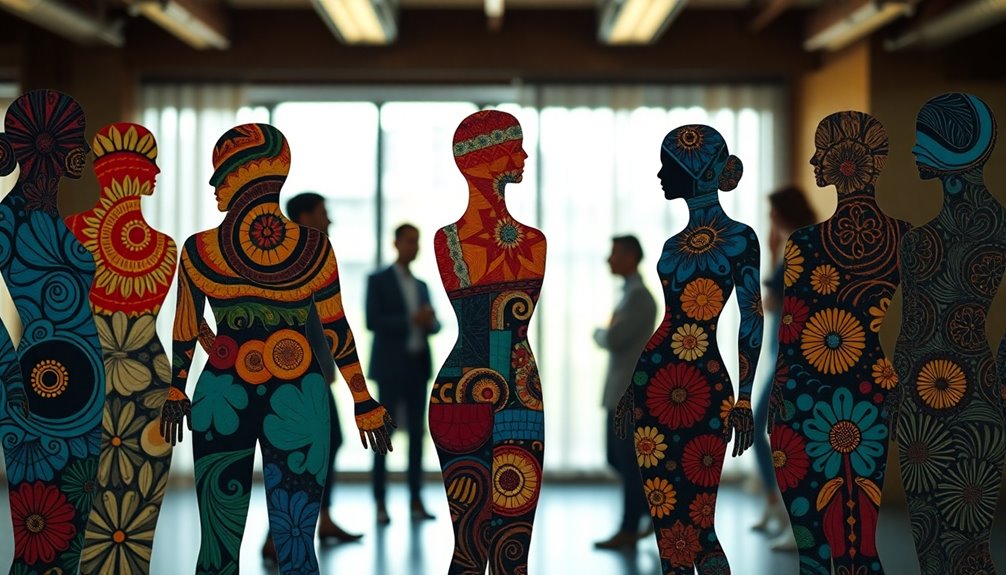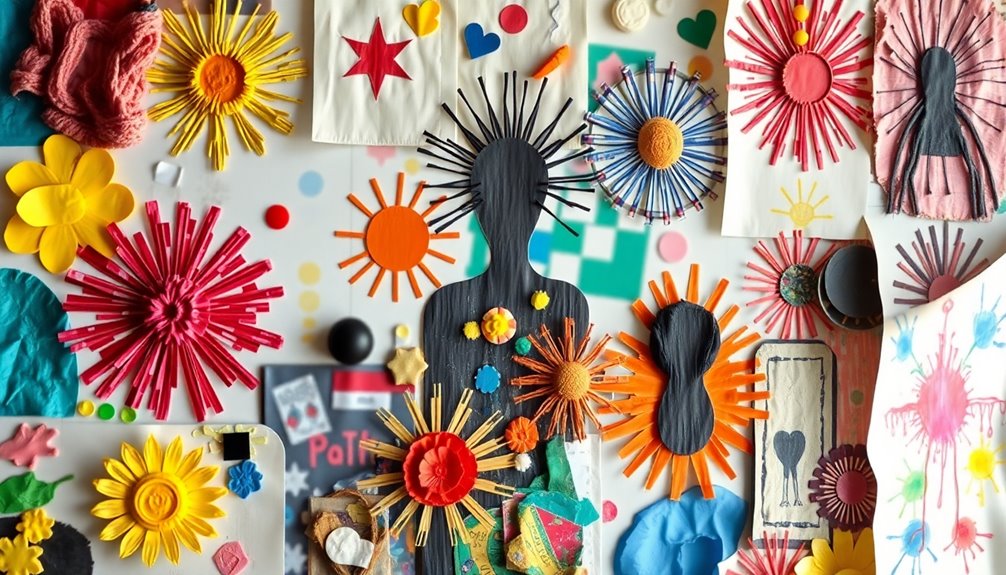To make your body biography project truly stand out, focus on creative visual elements that reflect key character traits. Use colors, symbols, and various artistic mediums to convey emotions and stories. Build a thematic timeline that highlights significant events in your subject's life. Collaborate with peers to gain diverse insights and enhance your project's depth. When presenting, engage your audience with engaging storytelling and interactive elements. Finally, seek feedback throughout the process to refine your work. By embracing these strategies, you'll create a compelling project that resonates well, opening the door to even more tips and techniques for success.
Key Takeaways
- Incorporate unique symbols and colors that reflect the character's personality and experiences, creating a visually striking representation.
- Use a mix of artistic mediums, such as drawings, collages, and digital tools, to showcase creativity and innovation.
- Highlight key quotes and themes that resonate deeply with the character, providing insight into their significance and impact.
- Engage your audience with interactive elements, like questions or activities, to foster connection and interest during presentations.
- Collaborate effectively within your group, assigning roles to ensure diverse perspectives and balanced participation in the project.
Understanding Character Traits

Understanding character traits is essential for grasping the complexities of individuals, whether in literature or real life. When you explore character traits, you can categorize them into four main types: physical, emotional, mental, and moral. Physical traits describe how someone looks, like being tall or strong. Emotional traits capture feelings and reactions, such as being sensitive or joyful. Mental traits reflect cognitive abilities, ranging from intelligent to ignorant. Finally, moral traits reveal a person's values, such as being kind or cruel.
You'll find that character traits can be positive or negative. Positive traits like generosity, integrity, and compassion enhance a person's interactions and relationships. In contrast, negative traits like dishonesty, selfishness, and cruelty can lead to conflict and misunderstandings. Furthermore, character traits influence leadership styles and how people connect with others. Understanding mental clarity can also play a significant role in how individuals express their character traits.
Understanding these traits not only enriches your literary analysis but also aids in personal growth. Characters often evolve, and their traits shape their journeys. By recognizing these traits, you gain insights into the driving forces behind behavior, helping you navigate both stories and real-life relationships more effectively.
Creative Visual Representations

Visual representations breathe life into character traits, making them more tangible and relatable. By creatively showcasing the essence of a character, you can deepen your audience's understanding and engagement. Here are some effective ways to elevate your visual projects:
- Incorporate symbols and objects that resonate with your character's experiences and values.
- Use colors with symbolic meanings to convey emotions and personality traits, enhancing the overall impact. Additionally, consider how certain scents can evoke specific feelings and memories, further enriching the emotional landscape of your character.
- Combine drawings, photos, and collages to narrate your character's journey, blending various artistic mediums for a richer story.
- Utilize typography and graphic design tools to create striking name designs and visual elements that capture attention.
These techniques not only enhance the aesthetics of your project but also provide a platform for storytelling. By merging visual elements with written analysis, you can offer an all-encompassing portrayal that reflects your character's goals, challenges, and accomplishments. Remember, the more creative you get with your visual representations, the more your project will stand out, making it memorable for your audience. Additionally, incorporating direct quotes from the text can further strengthen your character analysis and provide deeper insights into their motivations.
Engaging Group Collaboration

Effective group collaboration often leads to richer learning experiences and deeper insights. To foster this, divide your students into small groups of 3-5 members, balancing their skills and abilities. This diversity encourages creative problem-solving. When forming groups, use technology tools like LMS or specific group creation platforms to streamline the process, guaranteeing each group tackles a relevant topic related to the lesson.
Assign specific roles within each group, such as leader, note-taker, timekeeper, and presenter. This approach promotes equal participation and clarifies responsibilities. Rotate these roles frequently to distribute work evenly and keep everyone engaged. Provide clear guidance on how to fulfill each role effectively.
Incorporate collaborative learning techniques like the Jigsaw method, where students become experts in subtopics and teach their peers. Use peer teaching activities and the Think-Pair-Share strategy to enhance discussions. Monitor group dynamics to guarantee active participation and offer support when necessary. Encourage groups to share their findings with the class, allowing for diverse perspectives. Finally, utilize tools like Trello or Padlet for feedback and project management, promoting an environment of continuous improvement. Additionally, consider that collaborative learning encourages skill development through peer interactions, which can further enhance the overall learning experience.
Effective Presentation Techniques

After fostering teamwork through engaging group collaboration, it's time to focus on how to convey your findings effectively. To guarantee your presentation resonates with your audience, thorough planning is essential. You should research your topic deeply, organize your points logically, and maintain a clear structure. Here are some important techniques to enhance your presentation:
- Customize Content: Tailor your message to your audience's interests and comprehension.
- Engage Your Audience: Encourage participation through questions and interactive elements. Public speaking anxiety(#) is a common challenge, so addressing it can improve audience engagement.
- Utilize Multimedia: Incorporate visuals, videos, and storytelling to keep things engaging.
- Practice Delivery: Speak clearly and confidently, using effective pauses to let information sink in. Additionally, fostering an inclusive atmosphere can help ensure that all audience members feel valued and engaged.
Additionally, familiarize yourself with the presentation room beforehand to enhance your comfort level. Remember, managing your time effectively and limiting your slides can help keep the audience engaged. Finally, don't forget to use simple language and maintain cultural awareness to promote inclusivity. By applying these techniques, you'll not only convey your findings with confidence but also create a memorable experience for your audience.
Assessment and Feedback Strategies

Assessment and feedback strategies are essential tools that can greatly enhance student learning and engagement. Start by establishing clear learning objectives, ensuring students know what they're aiming to achieve. Use ongoing assessments like quizzes and class discussions to gauge their understanding. Timely feedback is vital; give input soon after assignments to maximize its relevance.
Encourage self-reflection, prompting students to think about their learning processes and recognize areas for improvement. Help them set specific goals based on your feedback, fostering a sense of ownership over their learning journey. Combine feedback with instruction, linking it directly to learning intentions and success criteria for continuous improvement. Additionally, incorporating various methods of assessment can provide a more comprehensive view of student progress.
Engage students critically—feedback should challenge them to think deeply about their work. Allow time for them to act on your feedback, enabling meaningful changes. Incorporate various forms of feedback, like written comments and peer assessments, to promote collaboration and self-assessment.
Frequently Asked Questions
How Can I Choose the Right Character for Analysis?
To choose the right character for analysis, focus on those with complex motivations, significant roles, and clear character growth. Consider their relationships, emotional responses, and how they influence the plot and other characters.
What Materials Are Best for Creating Body Biographies?
For creating body biographies, gather oversized paper for outlines, vibrant markers, and textured materials like fabric. Add symbolic items and quotes to enrich your character, transforming your project into a vivid expression of their essence.
How Can I Encourage Quieter Group Members to Participate?
To encourage quieter group members, create a safe environment where they feel valued. Use strategic pauses, direct questions, and varied interaction methods, ensuring everyone has a chance to share without pressure.
What Are Some Common Pitfalls to Avoid in Presentations?
To avoid common pitfalls in presentations, plan your content first, engage your audience, and practice thoroughly. Don't overload slides, speak clearly, and guarantee your delivery reflects enthusiasm to keep everyone interested and involved.
How Can We Incorporate Technology Into the Body Biography Project?
Incorporating technology into your project can boost engagement; studies show 80% of students learn better with digital tools. Use Google Slides for collaboration, online resources for research, and graphic organizers to structure your ideas effectively.









